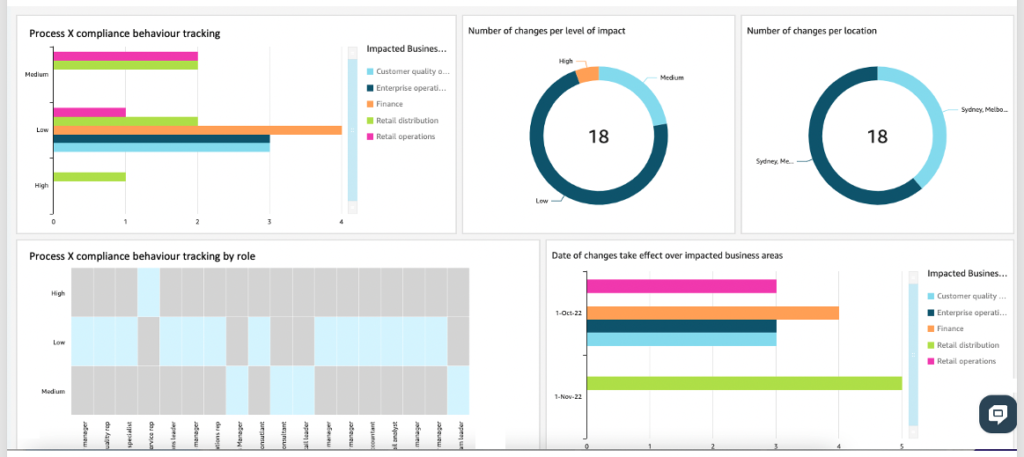Measuring change adoption is one of the most important parts of the work of change practitioners. It is the ultimate ‘proof’ of whether the change interventions have been successful or not in achieving the initiative objectives. It is also an important way in which the progress of change management can clearly be shown to the project team as well as to various stakeholder groups. The ability to show clearly the progress of change outcome is critical to focus your stakeholders’ actions on the right areas. It is one of the key ways to ‘prove your worth’ as a change practitioner.
Measurement takes time, focus and effort. It may not be something that is a quick exercise. There needs to be precise data measurement design, a reliable way of collecting data, and data visualisation that is easily understood by stakeholders.
With the right measurements of change adoption, you can influence the direction of the initiative, create impetus amongst senior stakeholders, and steer the organisation toward a common goal to realise the change objectives. Such is the power of measuring change adoption.
The myth of the change management curve
One of the most popular graphs in change management and often referred as the ‘change curve’ is the Kubler-Ross model. The model was specifically designed by psychiatrist Elisabeth Kubler-Ross to refer to terminally ill patients as a part of the book ‘On Death and Dying’. For whatever reason, it has somehow gained popularity and application in change management. Therefore, be very careful when using applying this model in a change context.
There is little research evidence to back this up even in psychological research. When applied in change management there is no known research that supports this at all. So be careful when you come across models such as this one that is simple and seem intuitively ‘correct’. On the other hand, there is ample research by McKinsey that for effectively managed initiatives and transformations, stakeholders do not go through this ‘valley of death’ journey at all.

The ‘S’ curve of change adoption
If the ‘change curve’ is not the correct chart to follow with regard to change adoption, then what is the right one to refer to? Good question.
The ‘S’ curve of change adoption is one that can be referenced. It is well backed in terms of research from technology and new product adoption. It begins with a typically slow start followed by a significant climb in adoption followed by a flattened level at the end. Most users typically do not uptake the change until later on.
Here is an example of key technologies and the speed of adoption in U.S. households since the 1900s.

With the different types of change contexts, the shape of the S curve will be expected to differ as a result. For example, you are working on a fairly minor process change where there is not a big leap in going from the current process to the new process. In this case, the curve would be expected to be a lot more gentle since the complexity of the change is significantly less than adopting a complex, new technology.
On the other hand, if you are working on many iterative agile changes, each iteration that impacts users may be a small S curve in themselves. Ideally, each iteration work together towards a greater piece of overarching change.
Going beyond what is typically measured
Most change practitioners are focused on measuring the easier and more obvious measures such as stakeholder perceptions, change readiness, and training completion. Whilst these are of value, they in themselves are only measuring certain aspects of the change. They can be viewed as forward-looking indications of the progress that supports moving toward eventual change adoption, versus the eventual change adoption.
Also, be aware of ‘vanity metrics’. These are metrics that do not connect to business outcomes, though they may ‘look good’ and easy to understand. To read more about vanity metrics check out this article.
To really address head-on the topic of measuring adoption, it is critical to go beyond these initial measures toward those elements that indicate the actual change in the organisation. Depending on the type of change this could be system usage, behaviour change, following a new process or achieving cost savings targets.
Project Benefit realization
It goes without saying that to really measure change adoption the change practitioner must work closely with the project manager to understand in detail the benefits targeted, and how the prescribed benefits will be measured. The project manager could utilise a range of ways to articulate the benefits of the project. Common benefit categories include:
- Business success factors such as financial targets on revenue or cost
- Product integration measures such as usage rate
- Market objectives such as revenue target, user base, etc.
These categories above are objectives that are easier to measure and tangible to quantify. However, there could also be less tangible targets such as:
- Competitive positioning
- Employee relations
- Employee experience
- Product or solution leadership
- Employee capability
- Customer experience
There could be various economic methods of determining the targeted benefit objectives. These include payback time or the length of time from project initiation until the cumulative cash flow becomes positive, or net present value, or internal rate of return.
The critical aspect for change practitioners is to understand what the benefit objectives are, how benefit tracking will be measured and to interpret what steps are required to get there. These steps include any change management steps required to get from the current state to the future state.
Here is an example of a mapping of change management steps required in different benefit targets:
| Project benefits targeted | Likely change management steps required | Change management measures |
| Increased customer satisfaction and improved productivity through implementing a new system. | Users able to operate the new system. Users able to improve customer conversations leveraging new system features. Users proactively use the new system features to drive improved customer conversations. Managers coaching and provide feedback to usersBenefit tracking and communications. Customer communication about improved system and processes Decreased customer call waiting time . | % of users passed training test. System feature usage rate. Customer issue resolution time. User feedback on manager coaching. Monthly benefit tracking shared and discussed in team meetings. Customer satisfaction rate. Customer call volume handling capacity. |
Measuring behavioural change
For most change initiatives, there is an element of behaviour change, especially for more complex changes. Whether the change involves a system implementation, changing a process or launching a new product, behaviour change is involved. In a system implementation context, the behaviour may be different ways of operating the system in performing their roles. For a process change, there may be different operating steps which need to take place that defers from the previous steps. The focus on behaviour change aims to zoom in on core behaviours that need to change to lead to the initiative outcome being achieved.
How do we identify these behaviours in a meaningful way so that they can be identified, described, modelled, and measured?
The following are tips for identifying the right behaviours to measure:
- Behaviours should be observable. They are not thoughts or attitudes, so behaviours need to be observable by others
- Aim to target the right level of behaviour. Behaviours should not be so minute that they are too tedious to measure, e.g. click a button in a system. They also should not be so broad that it is hard to measure them overall, e.g. proactively understand customer concerns vs. what is more tangible such as asked questions about customer needs in XXX areas during customer interactions.
- Behaviours are usually exhibited after some kind of ‘trigger’, for example, when the customer agent hear certain words such as ‘not happy’ or ‘would like to report’ from the customer that they may need to treat this as a customer complaint by following the new customer complaint process. Identifying these triggers will help you measure those behaviours.
- Achieve a balance by not measuring too many behaviours since this will create additional work for the project team. However, ensure a sufficient number of behaviours are measured to assess benefit realisation

Measuring micro-behaviours
Behaviour change can seem over-encompassing and elusive. However, it may not need to be this. Rather than focusing on a wide set of behaviours that may take a significant period of time to sift, focusing on ‘micro-behaviours’ can be more practical and measurable. Micro-behaviours are simply small observable behaviours that are small step-stone behaviours vs a cluster of behaviours.
For example, a typical behaviour change for customer service reps may be to improve customer experience or to establish customer rapport. However, breaking these broad behaviours down into small specific behaviours may be much easier to target and achieve results.
For example, micro-behaviours to improve customer rapport may include:
- User the customer’s name, “Is it OK if I call you Michelle?”
- Build initial rapport, “How has your day been?”
- Reflect on the customer’s feeling, “I’m hearing that it must have been frustrating”
- Agree on next steps, “would it help if I escalate this issue for you?”
Each of these micro-behaviours may be measured using call-listening ratings and may either be a yes/no or a rating based assessment.
To read more about measuring and driving behaviour change, check out our Ultimate Guide to Behaviour Change.
Establishing reporting process and routines
After having designed the right measurement to measure your change adoption, the next step would be to design the right reporting process. Key considerations in planning and executing on the reporting process includes:
- Ease of reporting, you should aim to automate where possible to reduce the overhead burden and manual work involved. Whenever feasible leverage automation tools to move fast and not be bogged down by tedious work
- Build expectations on contribution to measurement. Rally your stakeholder support so that it is clear the data contribution required to measure and track change adoption
- Design eye-catching and easy to understand dashboard of change adoption metrics.
- Design reinforcing mechanisms. If your measurement requires people’s input, ensure you design the right reinforcing mechanisms to ensure you get the data you are seeking for. Human nature is so that whenever possible, people would err on the side of not contributing to a survey unless there are explicit consequences of not filling out the survey.
- Recipients of change adoption measurement. Think about the distribution list of those who should receive the measurement tracking. This includes not just those who are in charge of realising the benefits (i.e. business leaders), but also those who contribute to the adoption process, e.g. middle or first-line managers.

Measuring Adoption Across Initiatives
You may be driving multiple initiatives as a part of a large program or a portfolio of initiatives. The key challenge here is to establish common adoption measures that are apple-to-apple metrics comparisons across initiatives. Yes, each initiatives will most likely have different sets of what constitutes adoption. However, there are still common ways to report on adoption across initiatives such as overall percentage of adoption of identified adoption elements, or percentage of the number of milestones reached. You can also utilise manager reports of behaviours adopted, as well as system records of utilisation of certain features for example.
Check out examples of change management adoption metrics here.
Check out our Comprehensive Guide to Change Adoption Metrics here.
To read more about change analytics and measurement visit our Knowledge Centre.
Understanding change adoption is not only helpful to understand what works for one initiative, it can also be a linchpin to help you scale change adoption across change initiatives across your whole portfolio. Talk to us to find out more about how The Change Compass can help you understand what change interventions leads to higher change adoption rates, through data. Using a data-led approach in deciphering what drives change adoption can truly drive successful change outcomes.
Feeling a bit lost and would like to have a chat about how to measure adoption by utilising digital solutions? Contact us here.






